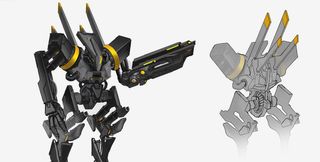
Science has a lot of running to do to catch up with the aspirational extremes of science fiction, but many of the concepts and technologies that you use to mould your futuristic society in Civilization: Beyond Earth are based on real world ideas and technology. Beyond Earth's sprawling technology web encompasses futuristic interpretations of biology, bionics and military science, so let's take a look at some of the real science behind those spectacular inventions.
Space lasers

Orbital units in Civilization: Beyond Earth have many uses, both helpful and destructive. By positioning a satellite in the orbital view you can buff cities and tiles positioned beneath it, or use an orbital weapon to devastate an enemy. The orbital weapons platform has long had a place in science fiction, whether you're reading Akira or watching James Bond try to shut down the Goldeneye platform. The reality of weaponised orbital units thankfully doesn't reflect the fiction.
This is thanks in part to the 1967 Outer Space Treaty, which forbade nations from sending nuclear warheads into space. The treaty was necessary at the height of the Cold War, when the militarisation of space began in earnest. The secret Soviet space station, Almaz 2, was equipped with a gun on-board to fend off potential boarding actions from US forces, though the whole space station would have to be rotated to aim the weapon, and there were fears that the kinetic force of firing the gun could destabilise the station's orbit.
But what about space-to-Earth orbital attack craft? These largely exist in theoretical forms. The Nazi regime designed heliobeam—a huge space mirror that would concentrate sunlight on a point on Earth's surface. The Soviet Fractional Orbit Bombardment system orbited Earth for 15 years during the Cold War, and was capable of guiding nuclear missiles in low orbit. That was decommissioned in the early '80s in accordance with space demilitarisation agreements.
Space-capable nations have been launching classified missions for decades, so it's impossible to say for sure that more elaborate space weapons aren't orbiting right now. On a new planet with no international treaties, like the ones envisioned by Civilization: Beyond Earth, there's every chance humanity could develop very effective orbital weapons platforms.
Bionic augmentation

In Civilization: Beyond Earth, you can choose to align your civ with one of three affinities. Each reflects a different philosophical approach to humanity's future. The technology of each faction is hugely important to their identity. The Supremacy affinity, for example, is all about using technology to help humanity advance its current form. They want to improve our human characteristics through advanced computing and superior bionic components.
Most of these ideas are far from feasible, but we've been augmenting the human form for a long time, as anyone wearing glasses or contact lenses will have experience of first-hand. Hugely successful Cochlear implants improve hearing in profoundly deaf people. Artificial hearts are frequently used as a bridge organ during heart transplants, and have sustained patients for years in lieu of a working organ.
Dramatic strides have also been made in limb-replacement technology for amputee patients. New limbs model the complex actions of a limb, of course, but the discipline also incorporates the development of machine-brain interfaces to allow the amputee to control their new limb with thought. This currently means painstakingly wiring nerves to the replacement limb—a difficult and expensive process for now.
Existing technologies are basic compared to the metal soldiers of Civilization: Beyond Earth, but it's a burgeoning area of science. It seems inevitable that we'll reach the dilemma faced by Beyond Earth's factions: when augmentations are better than our existing bodies, will we embrace machines completely like the Supremacy player, or hold onto our fleshy human forms like the Purity player?
Terraforming

The Purity affinity is dedicated to preserving humanity in its current state. They view the new planet they've settled on as a new paradise, a second Earth which can offer the species a second chance.
That means changes need to be made to the new world. While the planet is habitable, it isn't hospitable. Clouds of deadly miasma blanket the terrain and indigenous creatures patrol their territory. The Harmony player will seek to preserve the natural order of the planet, but others would rather change it to be more Earth-like.
That process is known as terraforming. It's largely a theoretical concept at the moment, but serious scientific thought has been given to the idea of reshaping worlds within our solar system to make them habitable.
Mars is a particularly interesting candidate, as it once held surface water. Its lack of magnetic atmosphere means it's currently too exposed to solar winds to settle on, but the introduction of huge amounts of greenhouse gases could theoretically create an atmosphere that could trap heat. The addition of water and earthen microbiology could then create an environment that would support plantlife. The oxygen output would eventually render the atmosphere breathable.
Another popular terraforming technique involves the construction of vast domes, which operate as miniature, man-made atmospheres and contain within them the gases and temperature conditions needed to support life. One of these actually exists on Earth. The Biosphere 2 is a huge biome in Oracle, Arizona that, for a time, enclosed a sealed artificial atmosphere and ecosystem. Scientists lived inside these systems for years, studying precise changes in the chemical makeup of the air and resident plantlife. Those experiments were shut down after the isolated scientists involved fell out and split into factions.
Luckily, the planets you settle on in Civilization: Beyond Earth already have an atmosphere, but it's sensible to build a small army of worker drones to build farms and scientific facilities near your cities. Satellites are also a useful terraforming tool, and can be used to burn away that inconvenient miasma.
Habitable planets and extraterrestrial life

Alien life is everywhere in Civilization: Beyond Earth. Every city starts out as a fragile outpost that must survive in a climate full of roaming siege worms, and other local critters. The Contact victory condition invites you to make contact with a technologically advanced alien race. How close are we to meeting an alien species?
Let's start small. Scientists have long suspected that Mars may hold the fossilised remains of bacteria, which could have thrived on Martian water. The findings so far have been inconclusive, but that hasn't stopped scientists from looking further afield. One hypothesis suggests that the chemical components of DNA and RNA—the building blocks of life—could form in outer space and travel on asteroids, giving impacted planets a better chance of generating life. Earlier this year NASA also revealed a database for tracking polycyclic aromatic hydrocarbons in the universe, which some theories suggest played a significant role in the origin of life on Earth.
But what about the search for sentient beings? Obviously, they haven't been discovered yet, but the SETI project is devoted to the search for extraterrestrial intelligence. They monitor electromagnetic radiation for signs of alien transmissions and radio telescopes scour the cosmos for any sign of intelligent signals. In Civilization: Beyond Earth you have to decipher the Progenitor code to make contact with the alien race, which might seem convenient, but we've been attaching cryptic guides to our cosmic location to our spacecraft for decades just in case they fall into the hands of a alien race beyond the edges of the solar system.
Astronomers, meanwhile, are busy searching for terrestrial planets similar to our own elsewhere in the galaxy. It's thought that the nearest star to ours, Alpha Centauri, could support planets capable of sustaining life, but the most recently discovered and potentially habitable planet is Kepler-186f, orbiting the red dwarf, Kepler-186, a mere 500 light years away.
That's just a small taste of the scientific basis for Civilization: Beyond Earth's most exciting technologies. Which piece of Beyond Earth tech would you most like to see developed in the real world?
The biggest gaming news, reviews and hardware deals
Keep up to date with the most important stories and the best deals, as picked by the PC Gamer team.
